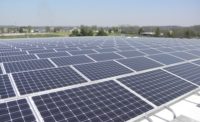Heating Up with Solar Cogen

Solar cogeneration eliminates the need to choose between two fundamental solar technologies. Images courtesy of Cogenra Solar. Images courtesy of Cogenra Solar.

Images courtesy of Cogenra Solar.

Images courtesy of Cogenra Solar.



Architects and facility managers are constantly looking to cut costs and foster long-term financial stability. While many agree renewable energy is an effective solution to meet sustainability objectives and improve the bottom line, selecting the right technology can be a difficult process. There are essentially two fundamental solar technologies available: 1) solar photovoltaic (PV), traditional solar panels that generate electricity, and 2) solar thermal, systems that generate heat for hot water and other operations that are typically fueled by burning natural gas. Both solar PV and solar thermal supply a valuable energy resource, so why choose between the two? Now, industry professionals don’t have to: solar cogeneration combines these two proven technologies, producing valuable electricity and hot water in one array.
Like traditional cogeneration or CHP (combined heat and power) solutions, solar cogeneration is optimized for facilities that use significant amounts of hot water on a daily basis. Environmental Design + Construction and Sustainable Facility have covered cogeneration solutions extensively before. These systems utilize waste heat created from natural gas turbines during electricity production to heat water. Solar cogeneration works in a similar fashion but eliminates the use of any non-renewable resources. Instead, solar cogeneration uses the power of the sun to generate clean, emission-free energy. As a result, solar cogeneration can be implemented in the same industries that have grown accustomed to traditional cogeneration — places such as hospitals and college campuses. The advantages are reduced greenhouse gas emissions and energy price stability.
How Does Solar Cogeneration Work?
Solar cogeneration, also known as solar cogen or hybrid solar, combines proven PV and solar thermal technologies in a single system to deliver both electricity and hot water. Despite years of incremental improvements, standard PV panels only capture about 15 to 20 percent of the sun’s energy. The remaining 80 to 85 percent is discarded in the form of waste heat. With solar cogeneration, this waste heat is captured and used to heat water, applying up to 75 percent of the sun’s delivered energy.
By tapping into this lost resource, solar cogeneration eliminates greenhouse gas emissions at nearly three times the rate of traditional PV panels. The process also reduces local VOC (volatile organic compounds) and NOx (nitric oxide and nitrogen dioxide) emissions released from the onsite burning of natural gas. In some air quality districts, avoidance of VOC and NOx pollutants can obviate regulatory burdens and associated fines.
System Integration and Impact
The solar modules are quickly assembled onsite — either ground or roof mounted — and designed to seamlessly integrate with existing hot water equipment. Depending on the facility’s needs, the water is heated through a closed-loop heat exchanger to temperatures around 70 C (158 F) to be used immediately, fed into boilers to be elevated to higher temperatures, or temporarily stored and applied during non-sunny hours. The electricity generated feeds directly to the facility’s existing power supply.
This dual production value makes solar cogeneration applicable for a variety of institutional and industrial applications. Quickly gaining traction, solar cogeneration is being deployed at a range of facilities from corporate campuses and schools to dairies and wineries.
Some of the most common uses for hot water are showers, laundry, cleaning, cooking and dishwashing. With that in mind, institutional sites that support a large community of people benefit greatly from the hybrid solution. For example, the University of Arizona recently decided to install solar cogeneration arrays on the rooftop of one of its dormitories to sustainably fuel student residents’ laundry and showers with hot water. Facebook recently signed up for solar cogeneration as well and is currently installing a rooftop solar cogeneration system for the fitness center at its new corporate campus in Menlo Park, Calif. Similarly, hotels, hospitals, cafeterias, correctional facilities, multifamily housing complexes, etc. can all reap significant energy savings by fueling amenities with solar hot water and electricity.
Energy-intensive industrial sites also need large quantities of hot water to process food, beverage, textiles, paper and pharmaceuticals. In this vein, the Sonoma Wine Company, Sonoma’s largest contract bottler, installed a system more than a year ago to reduce the costs of heating water needed for its routine tank and barrel washing systems.
By reducing natural gas and grid-fed electricity consumption in one solution, payback times are typically one-half to two-thirds that of standalone systems.
Financing Feasibility
Even with short payback periods, it’s understandable that the upfront capital cost may not be realistic with current business priorities. Government incentives, such as federal tax credits and accelerated depreciation as well as state-level rebates, have been implemented to attract private businesses to invest in renewable energy systems.
Alternatively, several financing models allow facilities to integrate renewable energy systems for little or no upfront costs. Taking on a “pay-as-you-go” model, facilities can opt to buy the energy produced rather than purchasing the equipment itself. Known as power purchase agreements (PPAs), or heat and power purchase agreements (HPPAs) in the case of solar cogeneration, facilities can hedge against volatile utility rates without redirecting capital from core business objectives.
Solar cogeneration is a highly efficient and environmentally sustainable solar solution for onsite energy generation. Compared to standard solar electric systems, hybrid solutions can produce five times the energy, three times the greenhouse gas reduction and twice the financial savings.
Looking for a reprint of this article?
From high-res PDFs to custom plaques, order your copy today!




.jpg?height=200&t=1722633170&width=200)



